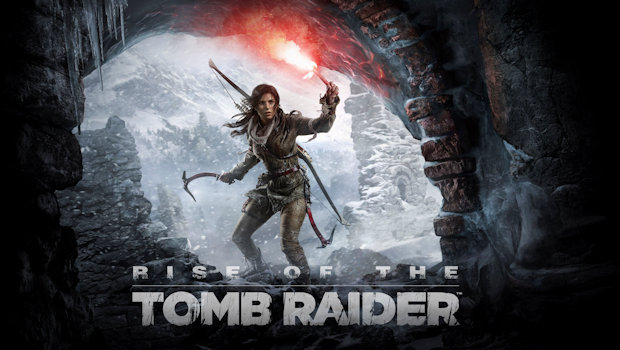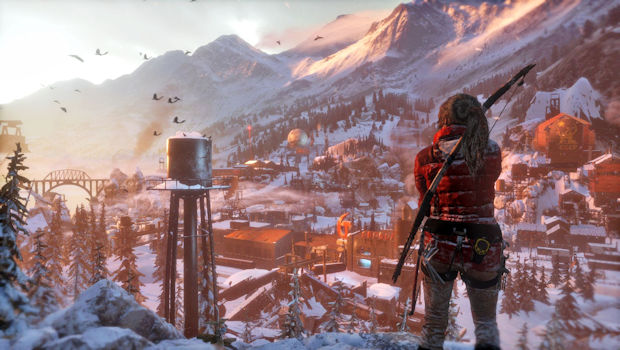Crystal Dynamics’ 2013 reboot of Tomb Raider modernized and revitalized the stagnant series, adding top-notch production values and turning it into a smart action game peppered with puzzles. We deemed it our Game of the Year, and after revisiting it last year, I believe we made the right choice. The recently released Rise of the Tomb Raider is a refined, sophisticated sequel to that raw, winning formula. Lara Croft is back and better than ever.
She returns as a hardened badass, no longer naïve or shocked by violence. I prefer her narrative arc in the reboot, as she transforms from innocent grad student to someone who has to fight to survive, but the story as a whole in Rise of the Tomb Raider is better and more interesting. Inspired by her supernatural encounters in the reboot and her late father’s research, Croft sets out to find a mythical city and perhaps the key to immortality. Standing in her way, determined to find the city before her, is a secret organization known as Trinity. It is standard Indiana Jones-style adventure fare, but there are some fun twists along the way, and the game does a good job of getting both you and Croft personally invested in her journey.
The structure of the game and nuts and bolts of the gameplay follow the blueprint of the reboot. It is an intoxicating mix of methodical platforming, environmental puzzle solving, and brutal third-person shooter combat. Levels are often capped off with an exhilarating escape sequence, in which Croft must run for her life as the level literally falls apart around her. Then you find find a bonfire where you can save and mull over how to spend your stat points. (Some of the upgrades are so cool.) Wash, rinse, repeat.
While Crystal Dynamics never really strays from the formula established in 2013, the developer has improved and enhanced each component of the gameplay. Combat, in particular, has way more options, such as stealth kills or the ability to craft explosives or special arrows on the fly (if you have the right materials), like in The Last of Us. Platforming and puzzles have a larger presence in the game. In fact, one of the game’s greatest feats is improving the mix between these elements, switching between them with ease and integrating them into the combat more often. The final level has you platforming, solving large environmental puzzles (some real head-scratchers near the end), and fighting hundreds of enemies all seemingly at the same time.
For people who criticized the first game for feeling like all combat all the time, you will find a much healthier mix. You still kill tons of dudes, and there is a lot of combat, especially in the last couple hours. The end of the game really cranks the combat up to 11, to the point where it could leave a bad taste in your mouth. At the same time, new fans who only played the reboot might be put off a bit by the amount of platforming and puzzle solving. I can certainly imagine players who stick to action games or shooters loving the combat only to be stumped and become frustrated with how much the game requires you to actually think.
On the flip side, old school fans lamented the severe lack of proper tomb raiding in the reboot, and Crystal Dynamics claimed they heard them loud and clear and promised to place a heavier emphasis on tombs in this sequel. Crystal Dynamics did not fulfill that promise. I personally feel like I was told a lie. There may be more tombs in Rise of the Tomb Raider, and some of them may be larger, but I can’t attest to that, and that doesn’t mean the game emphasizes them. Every tomb I raided was one room. Most areas contained roughly three tombs, same as the reboot. Many tombs I couldn’t find or couldn’t access because I didn’t have the proper tools yet. Now that I have beaten the game, I will have to backtrack and see if some of the areas I couldn’t access previously contain deeper tombs, but I’m not holding my breath.
Older Tomb Raider games featured at their core these large tombs that felt like Zelda temples built around a massive, tricky puzzle. That heart was excised for the action-focused reboot, and it hasn’t been restored. The fact that every tomb is still optional tells you everything you need to know. The last game was a commercial success no matter what Square Enix claimed at the time, and it seems they weren’t willing to take a risk by messing with success.
What we get as a compromise is the platforming and puzzle spirit of the series being injected more heavily into the new action core. There is never a dull moment, and as soon as you tire of one element, the game moves onto the next. It is an immensely satisfying gameplay loop that never lets up.
For comparison’s sake, remember Resident Evil 4? At its time, it was a great game that represented a huge departure for the series, but a great game nevertheless. Imagine if Resident Evil 5 were that but better and incorporated more puzzles and survival horror elements. Rise of the Tomb Raider is the equivalent of that correct version of Resident Evil 5 that never happened.
On the technical side, it’s a beautiful, nearly flawless gem. It looks, sounds, and feels amazing. This is the smoothest, prettiest gameplay experience in a long time. Unlike most games this generation, it is polished. The controls just feel right. The game never stutters. Performance never suffers. I even made it through the whole game without it crashing once. That alone might be worth an award or two.
It’s the type of game you just don’t get anymore. A big budget lengthy adventure that actually lives up to the hype, with tons to explore and collect. Those who seek out its best element—the tombs—are rewarded with significant upgrades. Scavenging in general is rewarding, even if the reward for finding many artifacts is just the simple joy of finding cool stuff. It is a busy holiday gaming season, but once the rush of Fallout 4 and others wear off, I’ll be back to find everything I missed.
And then I’ll start another playthrough.
Lightning has struck twice. Rise of the Tomb Raider is a great game, a must-play verging on a masterpiece.


